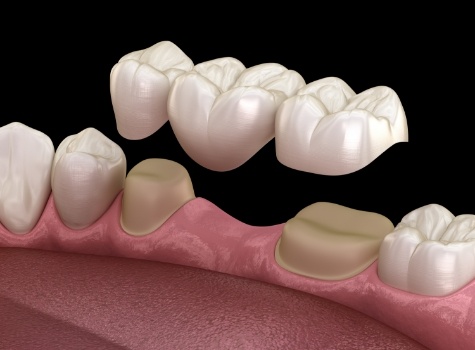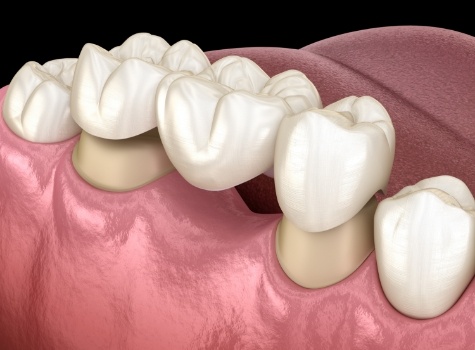Dental Bridges – Hoover, AL
Natural Restorations to Replace Missing Teeth

When it comes to the most basic tasks, including chewing and speaking, your teeth play an important role. They’re also responsible for helping you maintain proper alignment. While tooth loss is more common as you age, it doesn’t mean it can’t happen sooner in life. If you do lose teeth, they can be replaced via dental bridges in Hoover, AL. To learn more about this tooth-replacement solution, get in touch with our team at Moulton Dentistry of Hoover or read on!
Why Choose Moulton Dentistry of Hoover for Dental Bridges?
- Natural-Looking Emax and Zirconia Materials Utilized
- Dentist and Team Excited and Proud to Help Patients
- Dental Office Caters to Families and Patients of All Ages
What Is a Dental Bridge?

Dental bridges are well known for their ability to make chewing, smiling, and even speaking easier. But what exactly are they? A dental bridge is designed to fill the gap in your smile that appears as a result of tooth loss. Essentially, two dental crowns are attached to the adjacent teeth and the replacement tooth or teeth literally bridge the gap, restoring the look and function of your smile seamlessly.
Types of Dental Bridges

Depending on your dental needs, lifestyle habits, and preferences, your Hoover dentist will recommend a traditional dental bridge or an implant bridge:
- Traditional Dental Bridge – In this case, the abutment teeth (the teeth that are the foundation of your bridge) are dental crowns. Once in place, they can fill the space of one missing tooth or several consecutive missing teeth.
- Implant Bridge – With an implant bridge, dental implants are the foundation that keeps your restoration in place. Instead of dental crowns being attached to your natural teeth, the crowns are anchored to the top of the implant post, leading to increased longevity and much-needed jawbone stimulation.
The Benefits of Getting a Dental Bridge

Dental bridges come with several benefits, including the fact that they:
- Preserve your youthful face shape
- Protect your oral health
- Prevent misalignment
- Improve your bite, enhancing your digestion in the process
- Boost your confidence
- Last for 10+ years with proper care
- Enhance your speech
Dental Bridge Frequently Asked Questions
Do you still have some questions about dental bridges on your mind? Our team is here to answer all your questions about tooth replacement, whether it’s about the materials, proper care, or just the process in general. Keep reading for the answers to some of the most frequently asked questions or don’t hesitate to call our friendly staff!
How Is a Dental Bridge Attached?
Over the next two or three appointments, we’ll complete your bridge placement. During the first appointment, Dr. Moulton modifies your existing tooth structure on either side of the gap. This is done by removing a small amount of tooth enamel and dentin.
The bridge must be fabricated as precisely as possible so that your bite stays even and so the teeth on opposing sides of your mouth properly match it. To get the most accurate restoration possible, we take impressions of your modified teeth and send them to a dental lab. There, expert lab technicians construct your permanent bridge.
Typically, we adhere a fixed bridge to natural teeth sitting adjacent to the gap in your smile. False teeth, also known as pontics, are designed to replace your missing teeth. The dental crowns are cemented onto natural teeth, which allows for long-term support of the restoration.
What Materials Are Used for Dental Bridges?
Dr. Moulton primarily uses metal-free bridges made of zirconia and porcelain. If additional support is needed gold or precious alloys are available.
How Do I Take Care of My Dental Bridge?
Caring for your dental bridge starts with a dedicated oral care regimen at home. Always brush twice a day with fluoridated toothpaste and floss daily. Make sure to keep all the areas of the bridge clean. Since the bridge relies on neighboring teeth for support, it is critical that you practice daily care.
